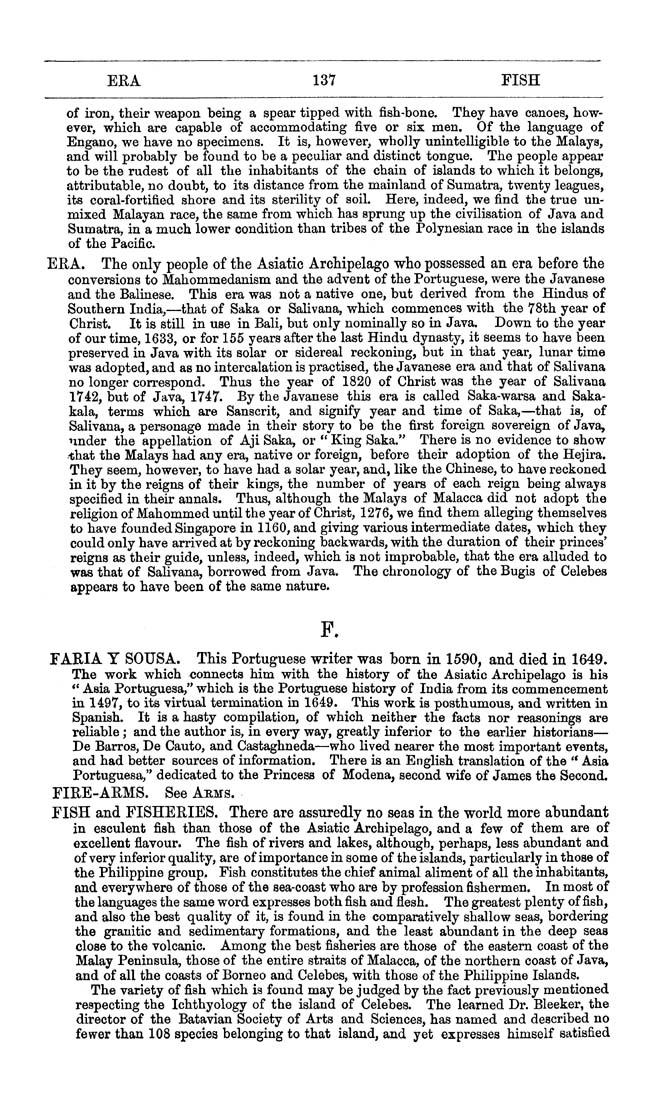ERA 137 FISH
of iron, their weapon being a spear tipped with fish-bone. They have canoes, how¬
ever, which are capable of accommodating five or six men. Of the language of
Engano, we have no specimens. It is, however, wholly unintelligible to the Malays,
and will probably be found to be a peculiar and distinct tongue. The people appear
to be the rudest of all the inhabitants of the chain of islands to which it belongs,
attributable, no doubt, to its distance from the mainland of Sumatra, twenty leagues,
its coral-fortified shore and its sterility of soil. Here, indeed, we find the true un¬
mixed Malayan race, the same from which, has sprung up the civilisation of Java and
Sumatra, in a much lower condition than tribes of the Polynesian race in the islands
of the Pacific.
ERA. The only people of the Asiatic Archipelago who possessed an era before the
conversions to Mahommedanism and the advent of the Portuguese, were the Javanese
and the Balinese. This era was not a native one, but derived from the Hindus of
Southern India,—that of Saka or Salivana, which commences with the 78th year of
Christ. It is still in use in Bali, but only nominally so in Java. Down to the year
of our time, 1633, or for 155 years after the last Hindu dynasty, it seems to have been
preserved in Java with its solar or sidereal reckoning, but in that year, lunar time
was adopted, and as no intercalation is practised, the Javanese era and that of Salivana
no longer correspond. Thus the year of 1820 of Christ was the year of Salivana
1742, but of Java, 1747. By the Javanese this era is called Saka-warsa and Saka-
kala, terms which are Sanscrit, and signify year and time of Saka,—that is, of
Salivana, a personage made in their story to be the first foreign sovereign of Java,
under the appellation of Aji Saka, or " King Saka." There is no evidence to show
that the Malays had any era, native or foreign, before their adoption of the Hejira.
They seem, however, to have had a solar year, and, like the Chinese, to have reckoned
in it by the reigns of their kings, the number of years of each reign being always
specified in their annals. Thus, although the Malays of Malacca did not adopt the
religion of Mahommed until the year of Christ, 1276, we find them alleging themselves
to have founded Singapore in 1160, and giving various intermediate dates, which they
could only have arrived at by reckoning backwards, with the duration of their princes'
reigns as their guide, unless, indeed, which is not improbable, that the era alluded to
was that of Salivana, borrowed from Java. The chronology of the Bugis of Celebes
appears to have been of the same nature.
F.
FARIA Y SOUSA. This Portuguese writer was born in 1590, and died in 1649.
The work which connects him with the history of the Asiatic Archipelago is his
** Asia Portuguesa," which is the Portuguese history of India from its commencement
in 1497, to its virtual termination in 1649. This work is posthumous, and written in
Spanish. It is a hasty compilation, of which neither the facts nor reasonings are
reliable; and the author is, in eveiy way, greatly inferior to the earlier historians—
De Barros, De Cauto, and Castaghneda—who lived nearer the most important events,
and had better sources of information. There is an English translation of the ** Asia
Portuguesa," dedicated to the Princess of Modena, second wife of James the Second.
FIRE-ARMS. See Aems.
FISH and FISHERIES. There are assuredly no seas in the world more abundant
in esculent fish than those of the Asiatic Archipelago, and a few of them are of
excellent flavour. The fish of rivers and lakes, although, perhaps, less abundant and
of very inferior quality, are of importance in some of the islands, particularly in those of
the Philippine group. Fish constitutes the chief animal aliment of all the inhabitants,
and everywhere of those of the sea-coast who are by profession fishermen. In most of
the languages the same word expresses both fish and flesh. The greatest plenty offish,
and also the best quality of it, is found in the comparatively shallow seas, bordering
the granitic and sedimentary formations, and the least abundant in the deep seas
close to the volcanic. Among the best fisheries are those of the eastern coast of the
Malay Peninsula, those of the entire straits of Malacca, of the northern coast of Java,
and of all the coasts of Borneo and Celebes, with those of the Philippine Islands.
The variety of fish which is found may be judged by the fact previously mentioned
respecting the Ichthyology of the island of Celebes. The learned Dr. Blocker, the
director of the Batavian Society of Arts and Sciences, has named and described no
fewer than 108 species belonging to that island, and yet expresses himself satisfied
|








